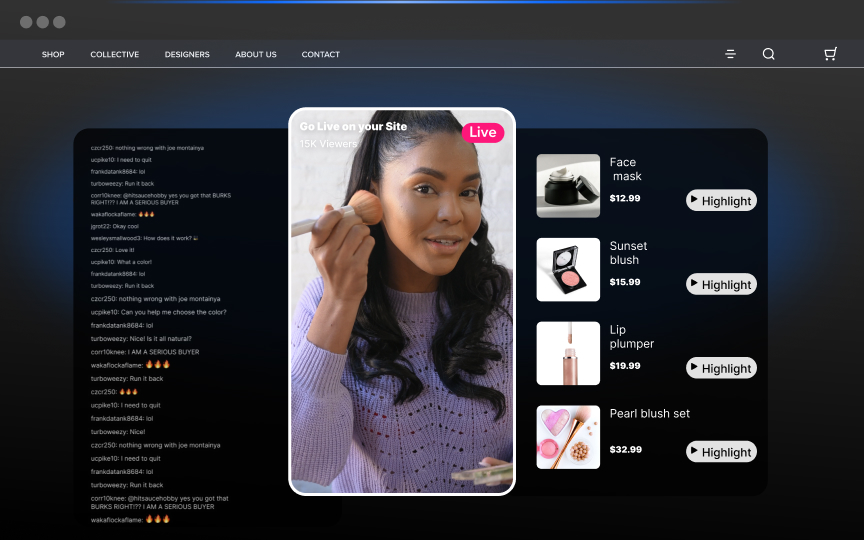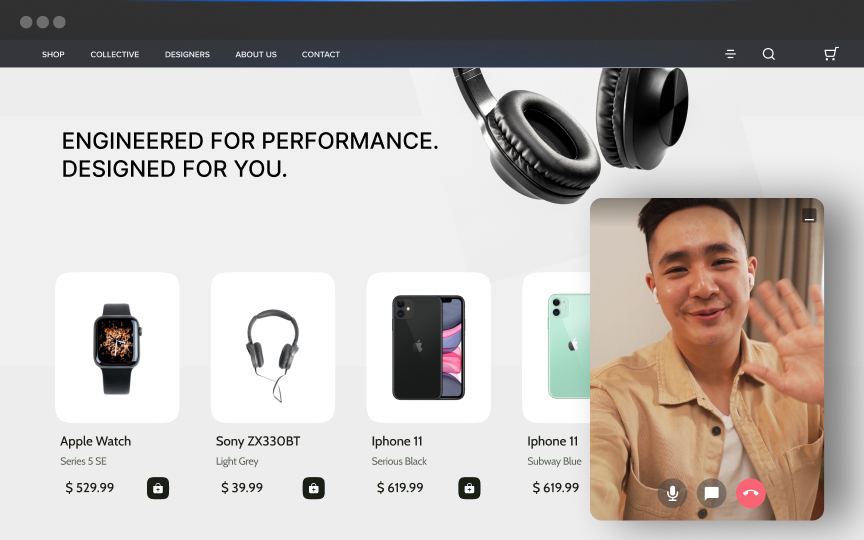In the fast-paced world of online retail, staying ahead of the key eCommerce trends for 2024 is crucial for business success.In this article, we will discuss 15 must-know trends that will shape the future of eCommerce, helping you drive customer engagement, boost sales, and streamline operations.
Trend 1: Social Commerce Will Continue to Grow
Social commerce platforms like Instagram and TikTok are transforming shopping experiences, allowing brands to reach new audiences through in-app purchases and product tagging.
Platforms Like Instagram and TikTok
Social commerce is booming on platforms like Instagram and TikTok, with brands increasingly leveraging social commerce to reach new audiences.An estimated 110.4 million people will shop via social channels in 2024, with the market projected to exceed $1 trillion—a 31% increase since 2022.Gen Z leads this trend, with nearly 60% purchasing directly from social media. Video content, especially short-form videos, is a primary driver, engaging users and showcasing products effectively.
Integrating Shopping Features for Smooth Experiences
Social media platforms are enhancing shopping features to create smooth customer experiences, including:
- Shoppable Posts: Clickable product tags for seamless purchases.
- In-App Checkout: Platforms like Instagram offer direct in-app purchases.
- Product Tagging: Brands can tag products directly in posts for easy exploration and buying.
By merging browsing and buying processes, these features encourage impulse purchases and higher engagement. Shoppable videos and live shopping events allow for real-time interaction, making the buying journey even smoother.
Trend 2: Augmented Reality (AR) Will Enhance Shopping Experiences
AR enables customers to visualize products in real-time, creating immersive, interactive shopping experiences that increase engagement and drive conversions.
Allowing Customers to Visualize Products in Real Time
AR technology overlays digital images onto real-world environments, helping customers visualize products before purchasing.Along with advancements in AI and AR in retail, beauty brands now offer virtual try-ons, and major retailers like Google and Walmart integrate AR for easier product fitting. By 2025, AR usage in the U.S. is expected to surpass 100 million users.
Increasing Customer Engagement
AR boosts customer engagement by making shopping interactive and personalized. Brands leveraging AR report higher engagement and conversion rates, as it reduces uncertainty and builds purchase confidence. By connecting online and in-store shopping experiences, AR transforms how consumers interact with brands.
Trend 3: Voice Search Will Influence Purchase Decisions
Voice assistants are becoming integral to eCommerce, with brands optimizing product information for voice searches to meet the rising demand for voice commerce.
Rising Use of Voice Assistants
Voice assistants like Amazon Alexa, Google Assistant, and Siri are becoming integral to online shopping. Projections show that by 2025, 75% of U.S. households will own a smart speaker.These devices help with product searches, recommendations, and even purchases, making voice commerce an emerging trend.
Adapting to Voice-Driven Commerce
To thrive in voice commerce, businesses must adapt by optimizing product information to be easily accessible via voice commands. Clear, concise product descriptions improve visibility and provide a seamless shopping experience for customers who prefer conversational searches.
Trend 4: Omnichannel Strategies Will Be Essential
Blending physical and digital experiences through omnichannel strategies helps brands provide seamless interactions, improving customer satisfaction and loyalty.
Combining Physical and Digital Experiences
Today’s consumers engage with brands across multiple channels, blending online and offline experiences in their purchase journeys. To succeed, brands should implement an omnichannel retail strategy by integrating physical and digital interactions, such as:
- Integrating QR Codes: In stores, link to online product content.
- Hosting Live Streaming Events: Show in-store activities for online audiences, effectively bringing the in-store experience online.
- Maintaining Consistent Branding: Ensure cohesive messaging across all platforms.
An omnichannel approach enhances the customer journey by providing seamless, consistent interactions, boosting both satisfaction and loyalty.
Trend 5: Sustainability Will Remain Important
Sustainability remains a top priority for consumers, with businesses adopting eco-friendly practices and transparently sharing their environmental impact to build trust.
Gaining Popularity Through Eco-Friendly Practices
Sustainability continues to influence consumer shopping behavior. Over 70% of shoppers say they’re willing to pay more for sustainably produced products. By embracing eco-friendly practices, businesses can attract environmentally conscious customers and tap into the growing second-hand market.
Being Transparent in Sustainable Practices
Being transparent about sustainability efforts builds trust and loyalty. Brands that openly share their eco-friendly initiatives resonate with consumers. Video content highlighting these practices can amplify your message and engage audiences effectively.
Trend 6: AI and Personalization
AI enhances personalization by delivering tailored shopping recommendations, automating customer support, and improving overall shopping experiences.
Enhancing Shopping Recommendations
AI in eCommerce has transformed the industry by delivering personalized shopping experiences. It analyzes customer data to offer tailored product suggestions, increasing engagement and conversion rates. Brands like Tapestry have seen higher click-through rates thanks to AI-powered personalization.
Automating Customer Interactions
AI also automates customer interactions through chatbots and conversational commerce, providing real-time responses and enhancing customer support efficiency. This improves customer satisfaction while reducing the need for human intervention in routine queries.
Trend 7: Livestream Shopping
Livestream shopping offers real-time product demonstrations, fostering trust and building a sense of community, which boosts customer engagement and sales.
Showcasing Products in Real Time
Livestream shopping allows brands to showcase products live, answer customer questions, and drive immediate purchasing decisions, enhancing the brand experience.Platforms like TikTok are heavily investing in live shopping features, contributing to the rise of livestream shopping. Brands are betting on its future growth as a key ecommerce driver and are closely following livestream shopping trends.
Building Community and Trust Through Interaction
Livestream shopping fosters a personal connection with brands, enhancing trust and loyalty. The real-time interaction helps in building community, which can deepen brand affinity and lead to repeat purchases.
Trend 8: Headless Commerce
Headless commerce provides flexibility by separating front-end user experiences from back-end functionality, improving site performance and customer satisfaction.
Offering Flexibility in Ecommerce Solutions
Headless commerce allows brands to decouple their front-end user interface from back-end functionality, offering more flexibility in building tailored shopping experiences across various touchpoints.
Enhancing Performance and Speed
By optimizing the front end independently from the back end, headless commerce improves website performance, which can boost user experience and search engine rankings, leading to higher visibility and customer satisfaction.
Trend 9: Hyper-Personalization
Hyper-personalization uses AI to tailor every aspect of the shopping experience to individual preferences, leading to higher customer retention and loyalty.
Tailoring the Shopping Experience
Hyper-personalization uses AI-driven personalization to customize every aspect of the shopping experience based on individual preferences. This level of customization increases customer satisfaction by making interactions feel more relevant.
Improving Customer Retention
Personalized experiences lead to higher retention rates. Implementing tailored loyalty programs and providing recommendations based on past behavior helps deepen relationships and boosts customer loyalty.
Trend 10: Influencer Marketing
Collaborating with influencers helps brands grow by expanding reach and building trust, particularly with younger audiences, through authentic endorsements.
Using Influencers for Brand Growth
Influencer marketing continues to be a powerful tool for expanding brand reach. Collaborating with influencers who resonate with your target audience helps drive conversion rates and increase visibility.Developing a robust influencer marketing strategy is essential for maximizing these benefits. Gen Z, in particular, often purchases directly from influencer-led content.
Building Trust Through Social Proof
Influencers offer social proof through endorsements, which enhances brand trust and reputation. By showcasing products authentically, influencers help brands gain credibility with skeptical consumers.
Trend 11: Direct-to-Consumer (D2C) Models
D2C models allow brands to bypass traditional retail channels, gain better customer insights, and build stronger relationships by directly interacting with consumers.
Bypassing Traditional Retail Channels
Brands are increasingly shifting to direct-to-consumer (D2C) models to bypass traditional retail channels. This gives businesses more control over the customer experience, improves profit margins, and allows for faster response to market trends.
Gaining Better Customer Insights
By interacting directly with customers, D2C brands have better access to data, enabling personalized experiences, improved product development, and stronger customer relationships.
Trend 12: Automation and AI
Automation streamlines operations like inventory management and customer service, reducing operational costs and enhancing efficiency.
Streamlining Operations and Customer Service
Automation and AI help businesses streamline processes like inventory management, order fulfillment, and customer service. This increases efficiency and improves customer satisfaction by speeding up response times and ensuring smooth operations.
Reducing Operational Costs
Automation also reduces operational costs by decreasing reliance on manual labor. AI-powered tools optimize logistics, inventory management, and data analysis, leading to more informed decision-making and greater efficiency.
Trend 13: Cryptocurrency Payments
Offering cryptocurrency as a payment option attracts tech-savvy consumers, reduces transaction fees, and meets diverse payment preferences.
Embracing New Payment Methods
Cryptocurrency is becoming more mainstream in ecommerce. Offering diverse payment options, including cryptocurrency, enhances the customer experience and reduces cart abandonment by meeting various customer preferences.
Minimizing Transaction Fees
Alternative payment methods, like cryptocurrency, often come with lower transaction fees than traditional payment processors, improving profitability and allowing businesses to offer competitive pricing.
Trend 14: Data Privacy Concerns
Consumers prioritize data privacy, making it essential for businesses to implement strong security measures and comply with evolving regulations to maintain trust.
Addressing Increased Awareness Among Consumers
Data privacy is a growing concern among consumers, influencing their shopping decisions. Customers are more likely to choose brands that prioritize protecting their personal information and being transparent about how their data is used.
Adapting to Regulatory Changes
With increased regulations surrounding data protection, staying compliant is essential. Businesses must implement strong security measures and stay informed about changing laws to maintain customer trust.
Trend 15: Rise of Subscription Services
Subscription models offer steady revenue streams and deeper customer relationships, with personalized services enhancing customer loyalty and retention.
Implementing Recurring Revenue Models
Subscription services provide businesses with a steady stream of predictable revenue. Offering subscription options encourages consistent customer spending and deeper relationships, providing financial stability and long-term growth.
Enhancing Customer Loyalty Through Personalization
Personalized subscription models that cater to individual preferences lead to higher satisfaction and loyalty. Customizable options meet customer needs more effectively, ensuring long-term retention.
Conclusion
By staying informed and embracing these 15 key ecommerce trends, you'll be well-equipped to adapt your business models, engage customers more effectively, and drive growth in 2024. Keeping pace with emerging technologies and consumer behaviors will give you the competitive advantage needed to succeed in the rapidly evolving digital marketplace.
Unlock Exclusive Insights
By submitting this form, you agree to Firework's privacy policy and consent to receive personalized marketing communications. You can unsubscribe at any time.




























